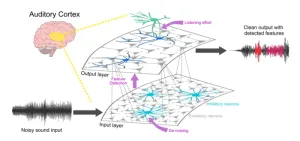(Press-News.org) COLUMBUS, Ohio – A new study analyzing data on over 20,000 U.S. adults links a healthier diet and increased exercise to weight loss that reduces heart disease risk – while associating skipping meals and taking prescription diet pills with minimal weight loss, weight maintenance or weight gain.
For many in the study sample, however, losing a “clinically significant” 5% of their body weight did not eliminate their risk factors for cardiovascular disease, results showed. In fact, the average composite score on eight risk factors for heart disease was the same across the entirety of the study population – regardless of reported weight changes, up or down.
The study is the first to compare weight-loss strategies and results in the context of the American Heart Association’s “Life’s Essential 8,” a checklist promoting heart disease risk reduction through the pursuit of recommended metrics for body weight, blood pressure, cholesterol, blood sugar, smoking, physical activity, diet and sleep. The AHA first defined a construct of cardiovascular health with “Life’s Simple 7” metrics in 2010, and updated the recommendations to the “Life’s Essential 8” in June 2022.
The Ohio State University researchers found that overall, U.S. adults had an average score of 60 out of 100 on the eight measures – suggesting there is plenty of room for improvement even among those whose diet and exercise behaviors helped move the needle on some metrics.
“The Life’s Essential 8 is a valuable tool that provides the core components for cardiovascular health, many of which are modifiable through behavior change,” said senior study author Colleen Spees, associate professor of medical dietetics in the School of Health and Rehabilitation Sciences at Ohio State.
“Based on the findings in this study, we have a lot of work to do as a country,” she said. “Even though there were significant differences on several parameters between the groups, the fact remains that as a whole, adults in this country are not adopting the Life’s Essential 8 behaviors that are directly correlated with heart health.”
The research was published recently in the Journal of the American Heart Association.
Data for the analysis came from 20,305 U.S. adults aged 19 or older (average age of 47) who participated in the National Health and Nutrition Examination Survey (NHANES) between 2007 and 2016. Participants reported their smoking status, physical activity, average hours of sleep per night, weight history and weight loss strategy, and what they had eaten in the previous 24 hours. Health exams and lab tests measured their body mass index, blood pressure, LDL (bad) cholesterol and blood glucose.
The Ohio State researchers used the data to determine individuals’ values for Life’s Essential 8 metrics and assessed their diet quality according to the Healthy Eating Index, which gauges adherence to U.S. Dietary Guidelines for Americans.
Within the sample, 17,465 individuals had lost less than 5% of their body weight, maintained their weight or gained weight in the past year. The other 2,840 reported intentional loss of at least 5% of their body weight in the same time frame.
“Clinically significant weight loss results in improvements in some health indices,” Spees said. “People should feel hopeful in knowing that losing just 5% of their body weight is meaningful in terms of clinical improvements. This is not a huge weight loss. It’s achievable for most, and I would hope that incentives people instead of being paralyzed with a fear of failure.”
In this study, adults with clinically significant weight loss reported higher diet quality, particularly with better scores on intakes of protein, refined grains and added sugar, as well as more moderate and vigorous physical activity and lower LDL cholesterol than the group without clinically significant weight loss. On the other hand, the weight-loss group also had a higher average BMI and HbA1c blood sugar measure and fewer hours of sleep – all metrics that would bring down their composite Life’s Essential 8 score.
A greater proportion of people who did not lose at least 5% of their weight reported skipping meals or using prescription diet pills as weight-loss strategies. Additional strategies reported by this group included low-carb and liquid diets, taking laxatives or vomiting, and smoking.
“We saw that people are still gravitating to non-evidence-based approaches for weight loss, which are not sustainable. What is sustainable is changing behaviors and eating patterns,” Spees said.
With federal data estimating that more than 85% of the adult U.S. population will be overweight or obese by 2030 (compared to the current rate of 73%), Spees said that to fend off related increases in heart disease and other health problems, a paradigm shift toward prevention is in order.
“We absolutely need to be moving toward prevention of disease versus waiting until people are diagnosed with a disease. This becomes quite overwhelming, and individuals may feel it’s too late at that point,” she said.
One idea to consider, she said, would be prescriptions for regular visits with registered dietitians trained in behavior change, complete with insurance reimbursement – similar to physical therapy.
“We have fantastic research, we have incredible educators,” she said. “What we don’t have is policy that promotes optimal health across the lifespan, from pregnancy through older adulthood.”
Co-authors of the study included first author Emily Hill (supported by a National Center for Advancing Clinical Sciences fellowship), Lauren Cubellis, Randell Wexler and Christopher Taylor.
#
Contact: Colleen Spees, Spees.11@osu.edu
Written by Emily Caldwell, Caldwell.151@osu.edu; 614-292-8152
END
New research published in PeerJ Life and Environment by Dr. Sarah Davis and sixty-one scientists from 12 countries presents a perspective to build consensus around the assessment and interpretation of Symbiodiniaceae diversity. Symbiodiniaceae is a family of marine dinoflagellates (plankton) notable for their symbiotic associations with reef-building corals, sea anemones, jellyfish, marine sponges and other marine invertebrates. Understanding Symbiodiniaceae is important to those working to protect and regenerate coral reefs that are under threat around the world.
"The authors hope this paper will provide a springboard to launch ...
The International World Wide Web Conference Committee (IW3C2) announced today that the 2023 Seoul Test of Time Award will be presented to the authors of the paper “A Contextual-Bandit Approach to Personalized News Article Recommendation;” Wei Chu, (Ant Group), Lihong Li, (Amazon), John Langford, (Microsoft) and Robert Schapire (Microsoft).
The award will be presented during the opening ceremony of the 32nd international conference in The ACM Web Conference series (formerly known as The International World Wide Web Conference) hosted by the team in Austin. See https://www2023.thewebconf.org ...
NEW YORK, NY (May 2, 2023)--A study of more than 2,200 adults who attended U.S. high schools in the early 1960s found that those who attended higher quality schools had better cognitive function 60 years later.
Previous studies have found that the number of years spent in school correlates with cognition later in life, but few studies have examined the impact of educational quality.
“Our study establishes a link between high-quality education and better late-life cognition and suggests that increased investment ...
RICHLAND, Wash. – While adding a little water is popularly thought to “open up” the flavor of whisky, a Washington State University-led study indicates there’s a point at which it becomes too much: about 20%.
Researchers chemically analyzed how volatile compounds in a set of 25 whiskies responded to the addition of water, including bourbons, ryes, Irish whiskeys and both single malt and blended Scotches. They also had a trained sensory panel assess six of those whiskies, three Scotches and ...
PITTSBURGH, May 2, 2023 — In a paper published today in Communications Biology, auditory neuroscientists at the University of Pittsburgh describe a machine learning model that helps explain how the brain recognizes the meaning of communication sounds, such as animal calls or spoken words.
The algorithm described in the study models how social animals, including marmoset monkeys and guinea pigs, use sound-processing networks in their brain to distinguish between sound categories – such as calls for mating, food or danger — and act on them.
The study is an important step toward understanding the intricacies and complexities ...
Every cell in our body is able to turn genes (DNA) on or off, producing RNA, but when genes are ‘turned on’ to the wrong level it can result in a variety of health conditions.
Rett syndrome is a rare neurodevelopmental condition that causes a loss of motor and language skills over time in girls. The condition is caused by a genetic variation in the MECP2 gene located on the X chromosome, resulting in affected nerve cells in the brain expressing the wrong levels of more than one thousand genes. The end result is that Rett syndrome nerve cells are smaller, less interconnected and less electrically active than healthy controls.
In ...
A new paper in the Quarterly Journal of Economics, published by Oxford University Press, indicates that an important part of the pay gap between men and women has to do with how they conduct job searches, with women more likely to accept job offers early while men tend to hold out for higher pay.
Women in the United States earn 84% of what men earn, as of 2020. This disparity is well documented, and economists and the general public have known about the earnings difference for decades. The reasons for this phenomenon are a matter of considerable debate.
Initial conditions in the labor market are long-lasting. Young workers who begin ...
Scientists dream of using tiny molecules as building blocks to construct things, similar to how we build things with mechanical parts. However, molecules are incredibly small - around one hundred millionth the size of a softball - and they move randomly in liquids, making it very difficult to manipulate them in a single form. To overcome this challenge, “nanofluidic devices” that can transport molecules in extremely narrow channels, similar in size to one millionth of a straw, are attracting attention ...
AMHERST, Mass. – Researchers at the University of Massachusetts Amherst and the University of Alaska Anchorage are the first to characterize two different types of surface water in the hyperarid salars—or salt flats—that contain much of the world’s lithium deposits. This new characterization represents a leap forward in understanding how water moves through such basins, and will be key to minimizing the environmental impact on such sensitive, critical habitats.
“You can’t protect the salars if you don’t first understand how they work,” says Sarah McKnight, lead author of the research that appeared recently ...
Embargoed for release until 5:00 p.m. ET on Monday 01 May 2023
Annals of Internal Medicine Tip Sheet
@Annalsofim
Below please find summaries of new articles that will be published in the next issue of Annals of Internal Medicine. The summaries are not intended to substitute for the full articles as a source of information. This information is under strict embargo and by taking it into possession, media representatives are committing to the terms of the embargo not only on their own behalf, but also on behalf of the organization they represent.
----------------------------
1. ...




